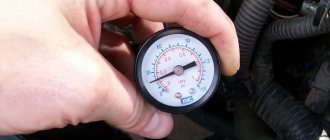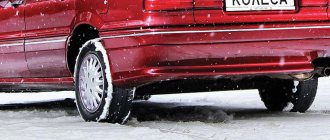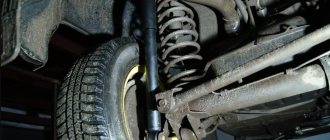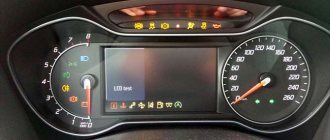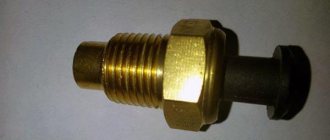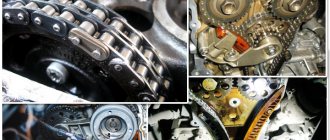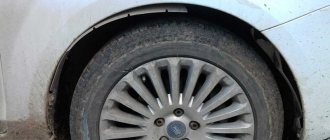Some car enthusiasts are afraid that when the ABS light is on, it somehow affects the operation of the braking system as a whole. They urgently begin to scour the entire Internet in search of an answer to why the ABS light is on and what to do. But don’t panic so much, the brakes on your car should be in perfect order, Only the anti-lock system will not work.
We propose to figure out together what will happen if you drive with a non-working anti-lock braking system. Let's look at all the common causes of problems and methods for eliminating them. To understand the operating principle of the system, we recommend reading about ABS.
What is ABS
The anti-lock braking system does not allow the wheels to “stand up” during sudden braking, dosing the deceleration force. ABS usually increases braking distance, but leaves the driver with controllability. A modern ABS system may also include traction control, dynamic stabilization devices and a brake assist system (BAS). A complex of such systems works for the benefit of active vehicle safety.
The ABS device includes several main components, including:
- Wheel speed and acceleration sensors located directly on the hubs;
- Hydraulic unit, including solenoid valves, pump and hydraulic accumulators (actuators);
- An electronic control unit (ECU) that ensures the system operates in the most efficient mode. Based on the information collected from the sensors, the device sends commands to the ABS actuators.
How to unlock wheels
Modern cars with traffic safety systems automatically unlock the wheels, preventing the brakes from jamming, even if there is a problem with the ABS and the light is on. What to do when the wheels are blocked:
- The first method is to try restarting the computer by removing the terminals from the battery and letting the car stand without power for 15-20 minutes. After returning the terminals, the wheels can be unlocked, then urgently go to the service station, without sudden braking, and eliminate the cause there;
- The second way is to turn off the ABS system by removing the corresponding fuse from the block under the hood of the car. If this helps to unlock the wheels, go to a service station and eliminate the cause;
- The third method is when the wheels were not unlocked in the first two ways. Call a tow truck and send the car to a service station in this way if the ABS has worked and does not release the brake pads. Driving with your brakes on means burning out your pads, rotors, transmission and engine.
Reasons for the anti-lock braking system light to come on
Normally, the ABS indicator on the instrument panel lights up for a few seconds and goes off every time the engine is started. If the icon is not displayed at this moment, the system is inactive and needs to be checked. There may be several reasons why the ABS light comes on:
- Broken wires;
- ABS sensors are dirty, disconnected or faulty;
- The ring gear on the wheel hub is damaged;
- The electronic system control unit does not function.
Regardless of the reason for which the ABS is on, the standard on-board computer collects information about the problems and analyzes it to generate an error code. The detection of a specific malfunction is indicated by the same warning light.
Diagnostics
You can check the performance of the ABS yourself without visiting a service station. To do this you need:
- remove the wheel sensor;
- remove contaminants;
- treat with kerosene;
- clean the wheel hub teeth from dirt;
- clean the reverse gear sensor;
- check that the electrical resistance matches that specified in the manual;
- lift the car using a jack;
- spin the wheel, measure the voltage in the sensor winding with a voltmeter;
- check the wear level of the bearings.
If the diagnostics do not reveal any problems, you should check the functionality of the fuses in the protective relay and the relay itself.
To confirm that the relay is working, you need to:
- disconnect the electrical unit connector;
- attach the voltmeter probes to the first two contacts of the block;
- turn on the ignition;
- measure the voltage of the on-board network;
- if it is missing, the problem is in the fuses;
- if no problem is identified, remove the relay;
- connect the battery terminals to pins 5 and 6.
The operating relay makes a clicking sound when activated. If they are missing, the relay is changed.
What is the danger of ABS failure?
If the indicator does not light up due to a burnt out bulb, solving the problem will not be difficult. Just replace it with a new one yourself or with the help of service staff. If the anti-lock braking system indicator comes on while the vehicle is moving, be extremely careful when braking sharply. Of course, a complete loss of control will not occur, but the car may skid. A failed system will prevent the vehicle from moving when the brake pedal is pressed, much less avoiding obstacles carefully.
And finally
If the ABS light is on, this does not always mean a serious breakdown in the car. It is better to always have a car scanner or the number of a good car mechanic on hand, who will help you quickly and inexpensively identify the problem. Also keep in mind that disabling the ABS system cannot always be done independently, without consequences. You can damage the operation of the ECU or other car systems. Therefore, if your ABS light comes on, contact a specialist.
Good luck on your journey. Until next time. Subscribe to our blog and stay tuned for new publications.
What can you do before going to a car service center?
If abnormalities are detected in the operation of the ABS, it is necessary to conduct a visual inspection of the system elements.
- The electronic control unit is checked for water inside the device and damage to the housing after disconnecting the brake pipes and wires. The ECU is located next to the brake force distributor. If you find liquid, the device must be blown out and dried. For safety, it is important to disconnect the battery.
- You can also check the serviceability of the fuses yourself. Several electronic components related to the anti-lock braking system are located on a common panel under the hood.
- It is advisable to inspect the wires connected to the sensors on the wheels as well. To do this, lift the car body with a jack so that the wheel hub area is clearly visible. This check allows you to detect wires that have flown off the fastenings or ground in.
If after the described actions the ABS light continues to light, check the activity of the system while driving. Accelerate the car to 40 km/h and sharply press the brake pedal all the way to the floor. When the ABS is working properly, vibration is felt; when the anti-lock braking system is turned off, there are no twitches. To conduct a thorough examination of the ABS components, the car must be delivered to a trusted car service center. The technicians will use a car tester to conduct computer diagnostics and analyze the error code of the anti-lock braking system. Sometimes you can fix the problem by “resetting” the error by removing the battery terminal.
If any car malfunction occurs, contact the official service centers of FAVORIT MOTORS Group of Companies.
Qualified specialists provide a full range of services for maintenance, diagnostics and repair of machines of foreign and domestic brands. Our technicians undergo regular training in authorized training centers, which guarantees high quality service at reasonable prices. In our work we use only original spare parts and reliable consumables. Take care of the safety of your car, trust the professionals! Technical center Ask a question
Options for self-diagnosis of the system if ABS lights up on the instrument panel
Experienced diagnostics recommends starting your own troubleshooting in the ABS system by visiting a car wash for a thorough, high-quality cleaning of the wheel rims and hubs. As a result, the sensors in the system can be cleaned to the greatest extent possible for the system to continue to function properly. If you turn on ABS later, follow the steps below.
You can also determine the cause of the ABS fault signal by performing a simple test: you need to accelerate the car and at a speed of about 100 km/h turn off the car radio and close the windows. If, as a result of the manipulations performed, external noise is heard in the area of the front or rear wheels, it is very likely that the bearing of one of the hubs has critical wear and requires replacement. In addition, you can perform the following manipulations:
- Check the fuse and, if it contains faulty elements responsible for the ABS system, replace them.
- If possible, try to determine the error code, which will help identify the faulty element in the system.
- Consult with an experienced mechanic, describe to him in detail the essence of the problem and, based on his advice, try to set up the system to work on your own.
- Check the condition of the brake control system sensors and clean them of dirt and corrosion. To access the sensors, simply jack up the vehicle and remove the wheels.
- Inspect and test the vehicle's electronic control system.
- Carry out diagnostics of the ABS system at a specialized service center.
Of course, the last item on the list will be completely justified, but also the most expensive, since this is the only way to correctly determine the source of the problem, determine subsequent tactics and budget for measures to eliminate it. Specialists will test all car systems using a special scanner and find errors. Thus, in a short period of time, all important information about the condition of the vehicle’s components is collected, possible errors are identified, which will help determine the malfunction as accurately as possible.
“ABS according to technical regulations” - on all roads in the country
Igor Pasynkov, head of transport company, Kurgan
— Since the adoption of the technical regulations, these ABS tricks have become eternal. It may subside, but it will appear again. There was such a big, big program to “sand” carriers in the Omsk region. “Skinning” is not childish! People wrote a bunch of complaints, and it calmed down, but in the Irkutsk region they suddenly started asking - what is the light bulb here, is it on or off...
Now I’m thinking – when will they reach trailers? This is where the fun begins, because, to be honest, there are less than half of trailers with working ABS. And a fire will blaze throughout the country.
If modest people in the Far East, in the east of Siberia, it starts with three rubles. And if these are snickering policemen in the black earth regions, on the European territory of Russia, then there are 25-30. This is where the conversation begins. With the current tariff policy, with the current uncertain economic activity in transportation, when any rogue can rob the carrier - what should he do? Where can I get money? How to deal with this? I don’t believe in the community, I don’t believe that it can consolidate in the fight against this idiocy, when everyone carries a C grade and is happy that he avoided the impound lot, although the C grade is probably all his earnings for this trip. What to do?
Let's start with the technical regulations
What kind of beast is technical regulation? The Technical Regulations on the safety of wheeled vehicles of the Customs Union, adopted by Russia, Kazakhstan and Belarus, outlines absolutely all the requirements for vehicles manufactured, imported and put into operation on the territory of the Customs Union. It lists everything from the front bumper to the tail lights. Engine, steering system, brakes, clutch - 370 pages of requirements, and not much space is devoted to ABS. The requirements for it are described in Appendix No. 8 (“Requirements for braking systems”).
1.15.1. The ABS must be complete and operational. There should be no visible damage, unreliable fastening, or disconnection of ABS elements.
1.15.2. The ABS operating status monitoring light must be in working condition, turn on when the ABS is activated after turning on the ignition, and turn off no later than when the vehicle speed reaches 10 km/h.
1.15.3. Vehicles equipped with ABS, when braking in running order (taking into account the driver's weight) at an initial speed of at least 40 km/h, must move straight within the traffic corridor, without skidding.
1.16. For vehicles with pneumatic braking systems, noise suppressors for compressed air escaping from the braking system must be tightly secured and functional.
That is, the technical regulations say that the ABS must be complete and operational - no questions asked. The question is: if the system is incomplete or inoperative, what punishment should be applied to the driver?
We should talk about the hierarchy of regulations. The basic document for the driver is traffic regulations, which have the status of government regulations. As a rule, all other documents expand, supplement and interpret certain norms and terms stated in the Traffic Regulations, paragraph 2.3 (driver responsibilities).
2.3. The driver of the vehicle is obliged to:
2.3.1. Before leaving, check and ensure that the vehicle is in good technical condition on the way in accordance with the Basic Regulations for the admission of vehicles to operation and the responsibilities of officials to ensure road safety.
It is prohibited to drive if there is a malfunction of the service brake system, steering, coupling device (as part of a road train), headlights and tail lights are not on (missing) in the dark or in conditions of insufficient visibility, the windshield wiper is not working on the driver's side during rain or snowfall.
If other malfunctions occur along the way, for which the operation of vehicles is prohibited by the appendix to the Basic Provisions, the driver must eliminate them, and if this is not possible, then he can proceed to the place of parking or repair in compliance with the necessary precautions;
Here, I especially note and emphasize, we are talking about the working brake system. About the main one, not the auxiliary or parking one. If the driver neglects his duties to maintain the technical condition of the vehicle, he will face punishment. Everything related to punishments is prescribed in Code of Administrative Offenses 12.5. Subparagraph 2 of this article deals with the punishment of a driver for driving a vehicle with a known faulty brake system (except for the parking brake), steering or coupling device of a road train, which entails an administrative fine of 500 rubles. To suppress the offense, Article 12.5.2 provides for a fine and the removal of the driver from driving the vehicle. That is, a car with faulty brakes or steering is driven into a parking lot, which is quite understandable and, probably, justified.
